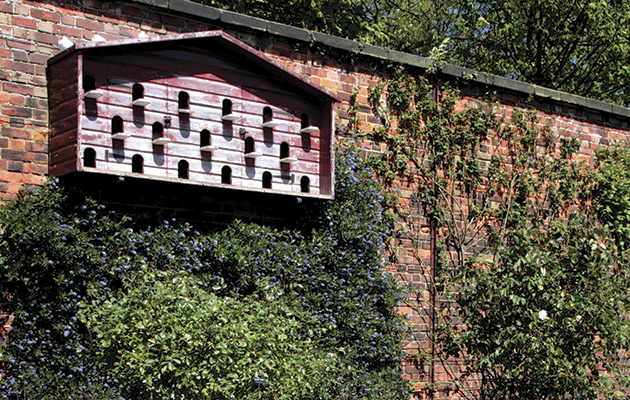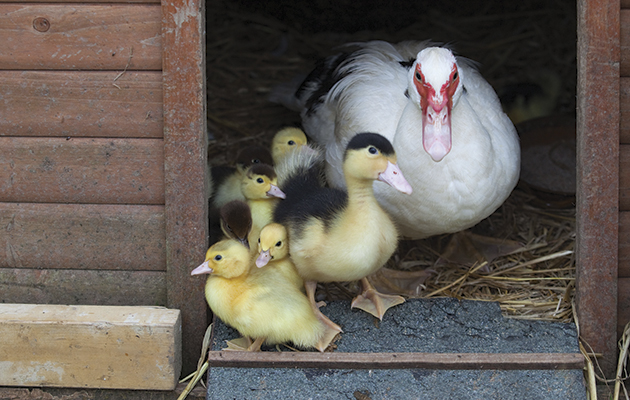Palatial luxury duck houses, made famous by the MPs' expenses scandal, are fabulous for fowl. But do they offer quacking good value, asks Charlotte Mackaness
Luxury duck houses hit headlines with the MPs’ expenses scandal a few years ago. Charlotte Mackaness investigates these palatial pads for fowl.
Wondering which ducks to keep, read our guide to the best duck breeds for your garden.
LUXURY DUCK HOUSES
Until a few years ago, any talk of luxury duck houses would most likely have been in the context of Peking, pancakes and plum sauce. No longer. Sir Peter Viggers’s £1,645 floating duck house became the symbol of the Parliamentary expenses scandal and the talk of the nation.
It may have cost the MP for Gosport his job but Britain’s knowledge of luxury duck houses was greatly enriched. Ivor Ingall of Heytesbury Bird Pavilions, who designed the 5ft-high duck house, says, “We had phenomenal publicity but I’m not entirely sure it was all good. What a lot of people don’t realise is that the claim wasn’t ever paid: even the expenses system in place back then refused to pass it.”
These luxury duck houses will set you back up to £2,500 today. Premium materials force up the seemingly quackers price tag. “They are all constructed to the very highest standards: the pontoons are made of tanalised Douglas fir, and the Stockholm Duck Island [the house that made all the headlines], has a hand-cut, fish-scale, lead-tile roof, which is very expensive,” explains Ingall.
While the duck house model made famous by the MP is the company’s best seller, it has others equally grand, including one based on a Queen Anne house and another inspired by a Gothic banqueting house. “They are all buildings I’ve seen on my travels and been impressed with. However, they are not slavish models. They are more of a caricature and definitely meant as a bit of fun,” insists Ingall. “We also take on bespoke commissions, often making houses based on the client’s own home.
HEYTESBURY BIRD PAVILIONS
“It all started in 2004 when my wife said she’d like a duck island. Rather than building one and then finding she wanted it a yard to the right, I created a floating house. They are anchored with three concrete pontoons, and some pavilions definitely need this, as large lakes can become quite choppy,” he explains.
Lakes big enough to make waves are not an issue for most of us but, according to Ingall, this is why the Heytesbury pavilions are so appealing: “The lovely thing is that it doesn’t matter if you don’t have a full-blown Palladian bridge in your garden; you can add your own architectural gem, albeit it on a much smaller scale. Our luxury duck houses are designed primarily as a garden folly; their use for birds is almost secondary.”
This is a sentiment Tory Darby can empathise with. Tory and her husband Keith were given a splendid duck house by an extremely generous friend as a surprise 50th birthday present. “It’s a very bucolic scene out of my kitchen window: there are ducks and swans on the water with red poll cattle grazing alongside. The duck house is painted in a tasteful Farrow & Ball palette and has a magnificent lead roof but, as far as I can tell, it has been totally ignored by the ducks. I’m secretly quite relieved if the truth be known. It looks so beautiful, I don’t really want the birds making a mess of it,” admits Tory. “Naturally, the duck house is a source of great amusement to our friends. And perhaps the birds are unsure of what to make of it also.”
VACANT LUXURY DUCK HOUSES
Vacant luxury duck houses are not uncommon. Ducks are notoriously pernickety and can turn up their bills at the most pukka pads. “They are terribly picky and if the house doesn’t take their fancy, they’ll just lay their eggs on the bank or make their own little nest elsewhere,” confirms Anne Weymouth of Dorset-based Flyte So Fancy, whose luxury duck houses account for about 20% of its sales of hand-built animal houses.”Their accommodation needs to be tough. If the ducks do take up residence, they won’t show any respect for their house and will make it mucky. They are certainly much messier than hens, something that can be a shock for chicken keepers branching out into ducks,” she says.
Not only are ducks less house proud than hens but they can also be headstrong. “They are much more free-spirited than chickens. They don’t particularly like being enclosed and seem to lack the self-preservation instincts of hens. They really ought to be rarer than they are,” says Rob Pellett of Forsham Cottage Arks, with a chuckle. “They can be very reluctant to go to bed at night, so it is sensible to fence in your pond but this isn’t always practical. Ducks out on a large lake are usually left to do their own thing but those closer to home, with a small pond, tend to be more easily domesticated,” explains Pellett.
Forsham Cottage Arks’ priciest duck pad is an £949 floating canopy. “The canopies are our best sellers and are tethered so you can pull them in but we don’t recommend fiddling too much because ducks won’t appreciate your efforts with spring cleaning: they like to collect twigs, leaves and all sorts of bits and bobs to help them get cosy and get very unsettled if these things are removed, even if only once a year,” he says. “Ducks love the mud and some are like little penguins the way they march up and down all day. If you’re very precious about your garden, ducks probably aren’t for you,” concedes Pellett. “That said, the small ornamental and call ducks can be less messy and there is definitely something aesthetically pleasing about pretty ducks and the smart luxury duck houses.
“We offer a bespoke service. I remember particularly a canopy that we painted a verdigris blue to match the client’s garden furniture. It sounds a bit strange and it did look a little odd in our workshop but in her garden it was stunning. Even the ducks were the same colour,” he reveals.
ADDING FLAIR TO FUNCTION
Adding flair to a functional duck house was very much the motivation of Jennifer Hirsch, whose fowl inhabit an American-style, red-and-white barn, complete with a silo for food, enclosed with a white picket fence. “There is absolutely no need to sacrifice aesthetics for practicality,” she insists. “It’s all about finding a way of incorporating your animal housing without creating an eyesore. I took the approach of, ‘Let’s do something fun and quirky to create a focal point.’ Gardens need destinations, intrigue, plays on perspective and a dose of humour. I used to have Jersey Giant hens and kept them in a house shaped like a grain silo, so I could accommodate their size attractively,” says Hirsch, who worked as a garden designer for many years.
“A friend of mine has a beautiful duck house. It’s a great addition to her garden in terms of its aesthetics. Most of the year it is empty but every spring a pair of mallards arrives and raises young in her house before flying off again. My friend sees their presence as a seasonal treat – a bit like autumn leaves.”
Hirsch is always thinking ahead to her next luxury duck houses and projects. “I could see myself doing a mini thatched cottage for my birds or even a church with a steeple. I like the idea of having something more vertical in shape than the barn; I’m thinking of something like a town house in which I could have ducks on the ground floor and hens on top. I’m also rather tempted to get a dovecote,” she enthuses.
THE ATTRACTION OF DOVECOTES
Indeed, so attractive are dovecotes as statuary that many gardeners don’t even bother with the doves. “I’d say over 60% of my customers never actually buy any birds,” reveals Mark Roberts, a former miner who now makes his living crafting exquisite luxury duck houses and other bird houses. “For many people, a dovecote is purely an architectural feature. However, I warn customers that do buy doves to start conservatively – they mate for life and breed very readily. Pretty as they are, if your garden is overrun with doves they could well start to annoy the neighbours,” he says.

Dovecotes are amazingly versatile and can be free-standing or attached to a wall, as in the Alnwick Garden.
Ensuring birds stay close to the dovecote can take time and patience. “Using a homing net is the kindest and easiest way, although it can take eight weeks,” explains Ian Stoakes of The Dovecote Co. “Once this is done, doves are quite low maintenance and very entertaining to watch. Dovecotes are divided into separate sections, so each pair can have its own compartment,” he continues. “There is often a pecking order, with a dominant male at the top. Usually, he’ll ensure that he gets the highest compartment in the dovecote for himself and his mate – the penthouse if you like.”
Stoakes receives orders from owners of urban semis and large country piles alike. Some of his dovecotes grace the famous gardens at Alnwick Castle. “They are amazingly versatile and don’t have to be free-standing structures in the garden; dovecotes also make wonderful architectural features on houses when fixed to walls or the ridge of a roof,” Stoakes says.
Architectural consultant Dave Suter claims that some of his most enjoyable projects have been “whimsical structures for birds”. One commission was a duck house for a client who had recently dug out a pond. “The water looked rather flat but the bird house lifted the scene by giving it a touch of focus,” he explains. “Creating something like luxury duck houses are usually a pleasure for both the client and architect, as there is great freedom to have fun and, because of their diminutive size, there’s usually no need to get a planning or building control officer involved.”
However, before going full pelt on designing the fanciest fowl house for miles, Suter counsels caution. “It must be done with great care. Given that most are situated close to water, bear in mind that the reflection means that often you’ll have not one but two bird houses to look at.”
LUXURY DUCK HOUSES: GET QUACKING AND CALL THESE FRIENDS OF FOWL
Flyte So Fancy
tel: 01300 345229
www.flytesofancy.co.uk
Forsham Cottage Arks
tel: 0845 872 0218
www.forshamcottagearks.com
Heytesbury Bird Pavilions
tel: 07836 672 857
www.birdpavilions.com
Mark’s Dovecotes
tel: 01443 832881
www.marksdovecotes.co.uk
tel: 07949 645231
www.thedovecoteco.co.uk









